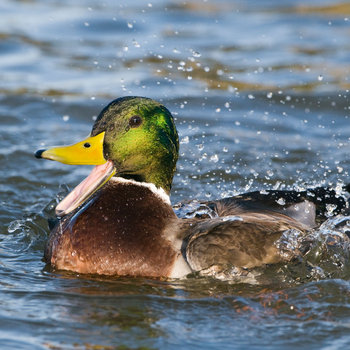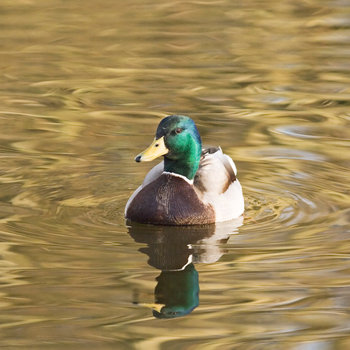

Mallard
- The expression “water off a duck’s back” is a reminder of the waterproof qualities of the feathers. They are kept waterproof by regular applications of oil from the preen gland.
- Scoring a duck in cricket reflects the fact that the 0 on the score sheet resembles the shape of a duck’s egg.
- Mallard remain a popular sporting bird: they can be shot inland from 1 September to 31 January.
- Ducklings are almost exclusively insect eaters, only turning to a mainly vegetarian diet as they get older.
- Historically, commercial duck decoys caught thousands of mallard every winter, with most of the birds caught being sent to Leadenhall Market.
- A duck doesn’t feed her brood, as they are capable of finding their own food as soon as they leave the nest.
- Once all the eggs have hatched the duck leads the brood away to water. They never return to the nest.
- A typical clutch is from nine to 13 eggs, but as many as 18, laid by the same duck, have been recorded.
- Incubation takes 27-28 days, and all the eggs hatch within the same 24-hour period.
- During the summer moult the drake loses his fine feathers and looks very much like the duck.
- Ducks will lay their eggs in a wide variety of sites, from grassy riverbanks to the tops of tower blocks. The downy young can survive jumps from great heights.
- The mallard displays classic sexual dimorphism, which means that the drake’s plumage is quite unlike that of the duck’s.
- Though they will pair up in the autumn, the drake only remains with his partner until she starts incubating, and has nothing to do with rearing the ducklings.
- The Victorians knew the mallard simply as the wild duck.
- Only the female, or duck, makes the familiar quacking. The drake’s call is a much softer and quieter note.
- Though northern populations are migratory, European mallard rarely move south of the Mediterranean.
- Mallard are widespread throughout Europe and Asia, occurring as far east as Japan, and they can also be found throughout much of North America.
- Mallard are one of the few species of birds to have been successfully domesticated: the mallard is the ancestor of such breeds as the Aylesbury, Khaki Campbell, Indian Runner, Silver Appleyard and Rouen.
- The mallard’s success is due to its adaptability, for it is a much at home on a town pond as it is on a Highland loch.
- Both sexes become completely flightless during the summer moult.
- Though generally regarded as the classic surface-feeding duck, up-ending in shallow water, they will dive for their food too if they need to.

